Cycle Superhighway 2 has rightly been receiving harsh criticism of late, following inquests in to the death of two cyclists on the route. From Aldgate, along Whitechapel Road and across Bow roundabout, CS2 was always the worst of the cycle superhighways, made up mostly of just blue paint on top of existing traffic lanes. But the route will very shortly be significantly extended, from Bow to Stratford, and this new cycle route could not be more different. London is about to get its first truly super cycle highway.
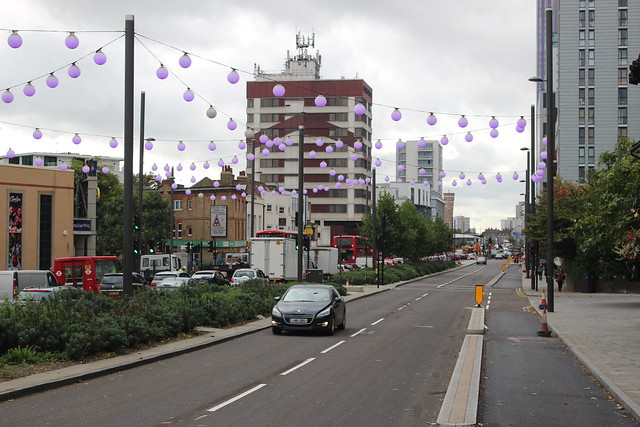
In a victory for campaigners who have been pushing for separated safe space for cycling since the last Mayoral election, the 3 kilometres of new cycle route are made up of largely segregated cycle tracks running either side of busy Stratford High Street. Separated cycling infrastructure has often received a lukewarm reception in cycle advocacy circles in the UK, usually because what has been built previously has been dangerously inadequate or dangerous. There should be no such issues in Stratford, with each bicycle track nearly 2 metres across on each side of the road, smooth, freshly painted, and free of obstructions (wide enough to drive your car down, as the builders demonstrated at the weekend as they finished building it!)

What's more, a raft of complementary measures will help to grow cycling culture in the area as part of the installation package. Local residents can expect to see some 400 new bike stands being installed along the route, improved signage and feeder bike lanes from adjoining roads, as well as free bicycle training for new or returning riders using CS2.
The bike tracks replace a lane of traffic in each direction on what was previously a six lane highway running through the heart of east London. Following the Olympics - when the new bike lanes were used as "Olympic family lanes" - TfL realised the space could be reallocated to other users whilst only delaying existing motorised traffic on the route during the AM peak by 90 seconds. For those who have been battling against TfL's "smoothing the traffic flow" network assurance concerns for many years, this is a very significant breakthrough.
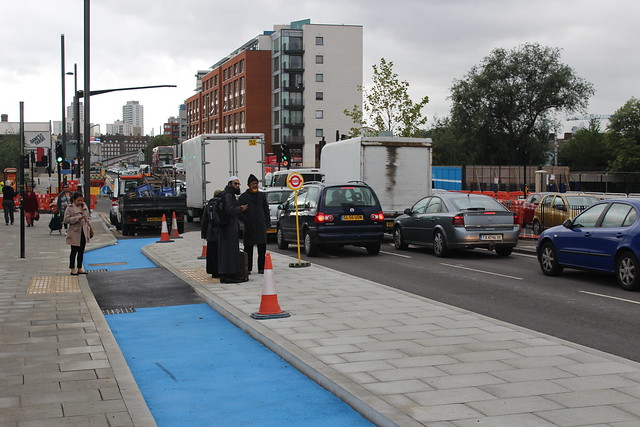
In a first of its kind for London, innovative bus stop bypasses will take the cycle track behind "floating" bus stops where passengers will wait to board. When buses stop to pick up passengers it will be the motorised traffic - and not more vulnerable cyclists - who have to move out in to the fast lane to overtake. To protect pedestrians, the cycle track narrows as it enters the bus stop bypass to encourage riders to slow down, and tactile pathing will help pedestrians with limited vision identify the safe crossing point. A "speed table" where the bike track raises to meet the level of the pavement has been installed to give a flat crossing surface to the bus stop island; great for raising awareness to cyclists that they are about to interact with pedestrians, and vital for those using the bus who may have limited ability or buggies and wheelchairs.

In a victory for campaigners who have been pushing for separated safe space for cycling since the last Mayoral election, the 3 kilometres of new cycle route are made up of largely segregated cycle tracks running either side of busy Stratford High Street. Separated cycling infrastructure has often received a lukewarm reception in cycle advocacy circles in the UK, usually because what has been built previously has been dangerously inadequate or dangerous. There should be no such issues in Stratford, with each bicycle track nearly 2 metres across on each side of the road, smooth, freshly painted, and free of obstructions (wide enough to drive your car down, as the builders demonstrated at the weekend as they finished building it!)

What's more, a raft of complementary measures will help to grow cycling culture in the area as part of the installation package. Local residents can expect to see some 400 new bike stands being installed along the route, improved signage and feeder bike lanes from adjoining roads, as well as free bicycle training for new or returning riders using CS2.
The bike tracks replace a lane of traffic in each direction on what was previously a six lane highway running through the heart of east London. Following the Olympics - when the new bike lanes were used as "Olympic family lanes" - TfL realised the space could be reallocated to other users whilst only delaying existing motorised traffic on the route during the AM peak by 90 seconds. For those who have been battling against TfL's "smoothing the traffic flow" network assurance concerns for many years, this is a very significant breakthrough.

In a first of its kind for London, innovative bus stop bypasses will take the cycle track behind "floating" bus stops where passengers will wait to board. When buses stop to pick up passengers it will be the motorised traffic - and not more vulnerable cyclists - who have to move out in to the fast lane to overtake. To protect pedestrians, the cycle track narrows as it enters the bus stop bypass to encourage riders to slow down, and tactile pathing will help pedestrians with limited vision identify the safe crossing point. A "speed table" where the bike track raises to meet the level of the pavement has been installed to give a flat crossing surface to the bus stop island; great for raising awareness to cyclists that they are about to interact with pedestrians, and vital for those using the bus who may have limited ability or buggies and wheelchairs.

There will undoubtedly be some confusion as to how people using the bicycle tracks who wish to turn right do so safely. Before their construction, cyclists in the kerb-side traffic lane would have had to move across a further 5 lanes of fast moving and heavy traffic before reaching the other side of Stratford High Street. Now, riders will be able to make an Anglicised version of a Copenhagen box turn. The video that TfL has produced showing you how to do this legally in the UK shows a somewhat ungainly solution that does the best dealing with current DfT-issued guidelines. However, in reality the best way to turn will be to pull over in to the Advanced Stop Line of the road to your left, before turning 90 degrees and proceeding across the main road when the lights turn green. (see the red line I have marked on the diagram below) For those approaching from side roads, the shared use pavements will allow you to - carefully - turn left and join the cycle track even when the traffic lights are red, thus eliminating any danger from moving off along with left turning motor vehicles. (As shown by the yellow line on my diagram below)
I do have some concerns about elements of the design I saw being constructed over the weekend, though I will reserve full judgement until the extension is completed and officially open. Some easy fixes would be to increase the length of the pedestrian "speed tables" for people joining the floating bus stops, or to install one at either end to discourage pedestrians from stepping in to the rest of the bike track. I'm also worried about the height of the curbs, which are flat-faced and do not allow for much wiggle room if you strike them. As pointed out to TfL during the consultation stage, slope-faced kerbs - though much more expensive - would allow cyclists to utilise the full width of the 2-metre lanes; useful when large groups are riding together or when faster riders wish to overtake slower cyclists with a bit of extra room for comfort. These should most certainly be installed on the bus stop bypasses, where the bike tracks are narrower, as a minimum. The opposing sides of the cycle track do not have equal geometry on the entry and exit "curves" of the bus stop bypasses, which could cause incidents when the tracks are very busy - I suspect this is down to a rushed installation based on unclear drawings, and is something that future schemes should seek to improve on.

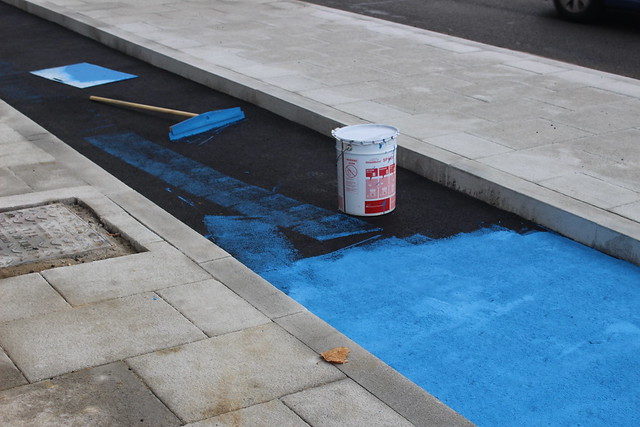
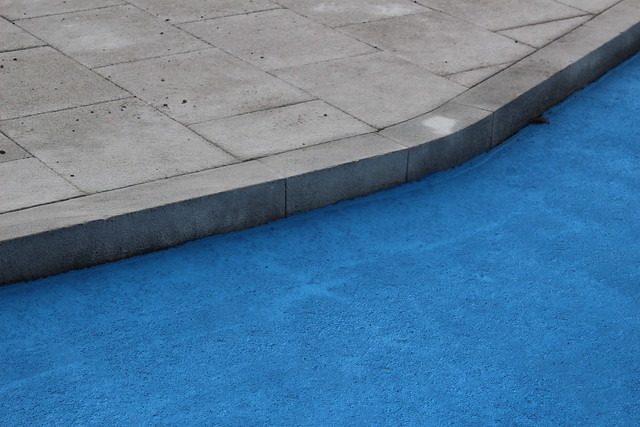
It's worth remembering that cycle tracks on this scale have not been built by Transport for London before, and it will have been a steep learning curve for their engineers. The scheme will not be perfect to begin with, but it is already head and shoulders above anything built on TfL roads previously. Yes, there are niggles and refinements that need to be ironed out, but at least the tracks are safe and operable to start with (more than can be said than another "cycle facility" recently installed in neighbouring Tower Hamlets)
For me, what is most exciting about these cycle tracks is that they will help to animate Stratford High Street with actual people. Historically, this has always been a severely car-choked highway with a serious air quality problem, designed primarily to speed along traffic that originates from outside the area. And yet, when you spend time on the road, you begin to see that there is life here. In addition to rows of terraced housing just off the main road, there is a church, a nightclub, some great restaurants and cafes, a University campus and student accommodation, a number of hotels, a supermarket, a primary school, and a bingo hall along the route. Soon, a resident living on the route will be able to safely cycle to the town centre, or even Westfield, using the CS2 extension. And connecting with the route are the Bow roundabout floating underpass and canal-side traffic-free routes along the River Lea and Bow Back Rivers, as well as the 7km Greenway walking and cycling path from Beckton to Victoria Park, as well as the Queen Elizabeth Olympic Park itself. Once the QEOP is fully open and the Greenway re-connected after Crossrail stops digging up most of Pudding Mill Lane late next year the Cycle Superhighway 2 extension will connect with miles of traffic-free cycle routes, creating the beginning of a safe and comfortable cycle network in the area.
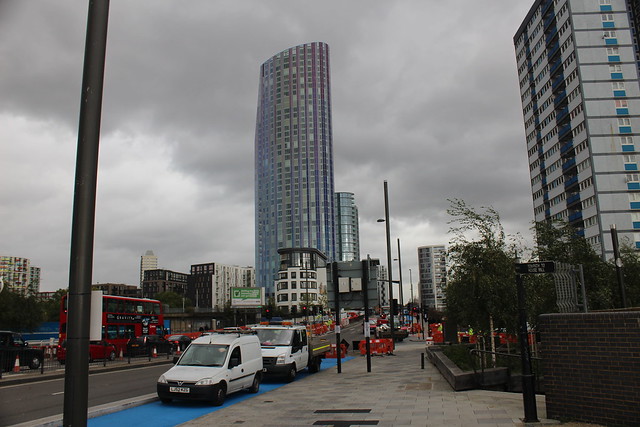
And just as Stratford High Street is changing, so too will the profile of cyclists here. These facilities will allow older riders, children, more women and even less abled cyclists the opportunity to ride here - something you would not have seen when this was a six lane wide road. In turn, those riders will have to learn to take extra care on the bus stop bypasses of pedestrians - particularly those who are less mobile - something that will be encouraged by the speed tables and additional signage.
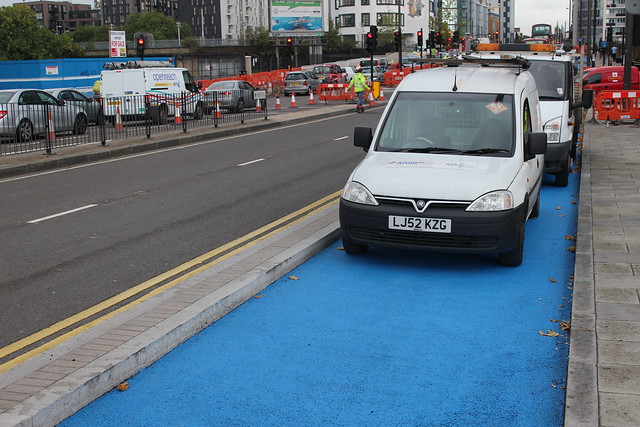
There will be some in cycle campaigning circles who will hate these cycle tracks because of long-held feelings that separating cyclists is not the right way to go, that it is some kind of surrender. At the other end of the spectrum, hardened advocates will argue that these designs are 'not Dutch enough'. To both I say this; TfL have had to install separated cycling infrastructure under the duress of a UK legal and road rules system that simply doesn't yet know how to accommodate such plans. As such, their hands are tied with how far they can push the envelope. For most of the route, the cycle tracks are so wide that you could drive a car down them. Indeed, a lane for motorised traffic has been lost here in both directions. It's not very often we get to congratulate TfL on a job well done, and to those quick to criticise I would say this; reserve your judgement before you've actually come here to Stratford and ridden the tracks yourself, and seen them in situ. They're not perfect, and there are lessons for TfL to learn, but they're a damn site better than anything built on a major London road before.
I for one can't wait for more of London to start looking like this; let's start with the shocking state of the rest of CS2 down Whitechapel Road shall we?
Share |









